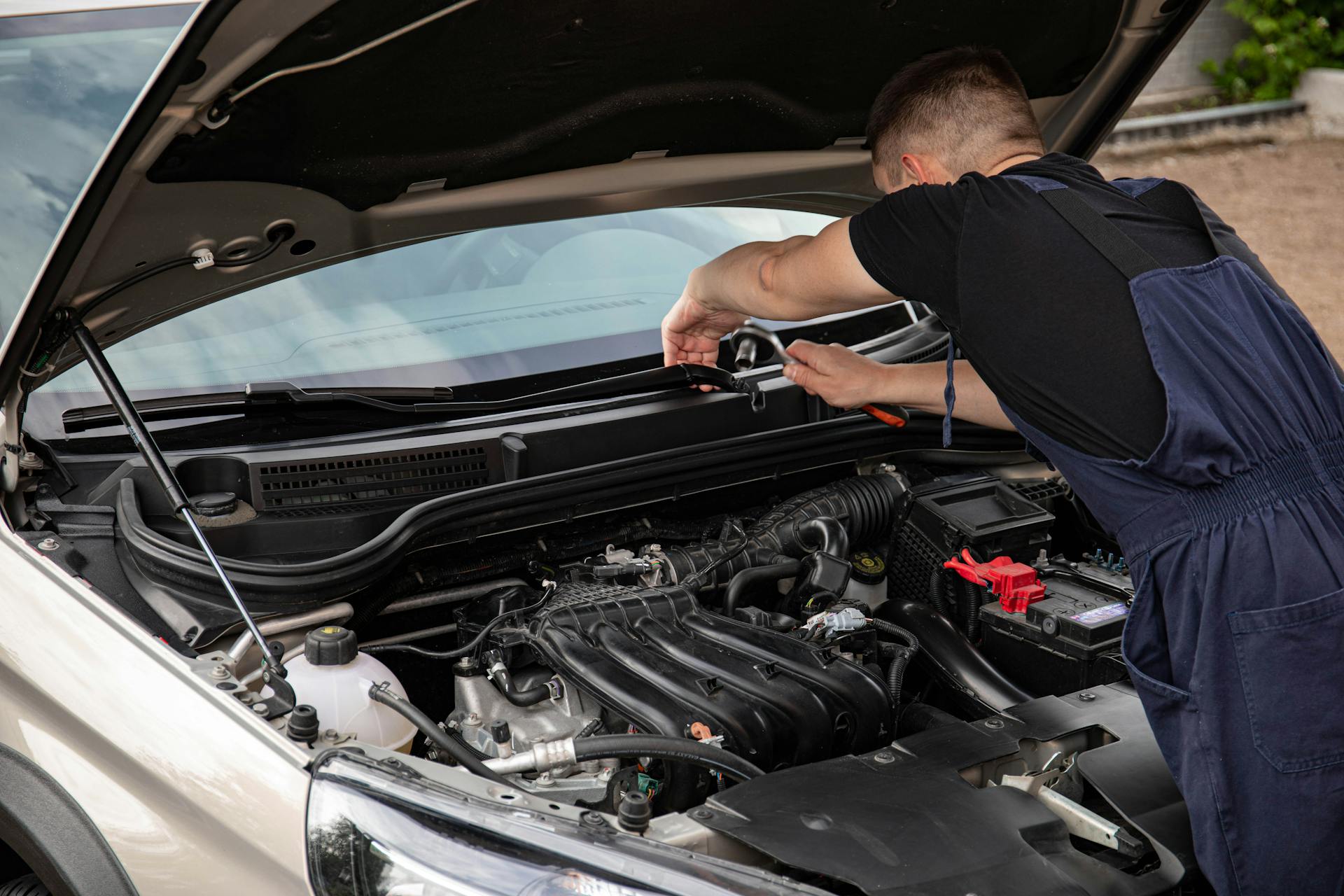
The end of a car lease can be a stressful experience, but it doesn't have to be. Most car leases last between 24 and 48 months.
In the final months of your lease, you'll receive a lease end notice, typically 30 to 60 days in advance, informing you of the lease end date and outlining your options. You'll also receive a vehicle inspection report to determine the condition of your vehicle.
The inspection report is crucial in determining the lease end charges, which can range from $300 to $600, depending on the vehicle's condition. This fee is to cover any excessive wear and tear.
You have three main options at the end of your lease: return the vehicle, purchase the vehicle, or lease a new vehicle.
Preparation
Before you start negotiating, it's essential to know your vehicle's market value. This will give you a solid foundation for your negotiations and help you make informed decisions.
Research your vehicle's market value using tools like Kelley Blue Book or Edmunds, and aim to sell your car for at least 90% of its value.
Having a clear understanding of your vehicle's condition is crucial for negotiations. Be honest with yourself about any damage or wear and tear, and make a list of the necessary repairs.
Keep in mind that some damage may be considered minor, but it can still impact your vehicle's value. For example, a small scratch on the bumper might only reduce your vehicle's value by $100.
Knowing your vehicle's mileage is also vital. If you've exceeded the average mileage for your vehicle's age, it may affect its value. For instance, if your vehicle has 60,000 miles but is only two years old, it may be considered high mileage.
Having all the necessary documents, such as the lease agreement and maintenance records, will help you prove your vehicle's condition and value.
Lease Terms
Lease terms can be overwhelming, but understanding the basics will help you make informed decisions during negotiations. The capitalized cost, also known as the cap cost, is a good place to start negotiating, as it affects your monthly payments. Research the vehicle's actual cost to get a better idea of a potential price range.
Some factors of a lease aren't negotiable, such as the residual value and lease-acquisition fee. The residual value is usually set by independent car-value experts, while the lease-acquisition fee covers the leasing company's costs to set up the leasing transaction. Knowing this can help you focus on negotiating other aspects of the lease.
Here are some key lease terms to consider:
- Capitalized Cost (Cap Cost): The agreed-upon price of the vehicle, which affects your monthly payments.
- Residual Value: The estimated value of the vehicle at the end of the lease, which can impact your monthly payments.
- Money Factor: The lease equivalent of an interest rate, which affects your financing costs.
- Mileage Limit: The annual mileage limit, exceeding which incurs additional charges.
Leasing Basics
The capitalized cost, also known as cap cost, is a crucial number to understand when leasing a car. It's the agreed-upon price of the vehicle, similar to the purchase price.
You can negotiate the cap cost, just like you would if you were buying the car. Research the fair market value of the car using tools like Kelley Blue Book or Edmunds to find a good starting point.
The money factor, a financing charge similar to a loan's interest rate, is another important term to know. You can multiply the money factor by 2400 to view the charge as an annual percentage rate (APR).
A higher residual value, the estimated value of the vehicle at the end of the lease, can result in lower monthly payments. However, exceeding the annual mileage limit (usually 10,000-15,000 miles) incurs additional charges.
Here's a breakdown of the key terms to know:
- Capitalized Cost (Cap Cost): The agreed-upon price of the vehicle.
- Residual Value: The estimated value of the vehicle at the end of the lease.
- Money Factor: A financing charge similar to a loan's interest rate.
- Mileage Limit: The annual mileage limit, usually 10,000-15,000 miles.
By understanding these leasing basics, you'll be better equipped to navigate the leasing process and make informed decisions.
Mileage Allowance
Mileage Allowance is a crucial aspect of leasing a car. Most leases limit the number of miles you may drive, typically to 10,000 to 12,000 miles annually. If you exceed this limit, you'll face a penalty.
It's essential to know your driving habits to negotiate a higher mileage allowance. If you commute frequently or take road trips, you'll want to choose a mileage plan that matches your needs. You can negotiate a higher mileage limit upfront to avoid costly overage fees, which can be as high as $0.25 per mile.
To give you a better idea, here are some common mileage allowances and their corresponding fees:
Negotiating a higher mileage cap upfront can save you money in the long run. However, keep in mind that this will decrease the residual value of the vehicle and the buyout amount.
Rent or Money Factor
The rent charge, also known as the money factor, is a crucial aspect of your lease agreement that can significantly impact your costs. Dealerships may try to make you believe it's non-negotiable, but it's actually a number that can be marked up to increase their profit.
You should ask for the money factor directly, as dealerships aren't required to disclose it. Research which automakers are currently offering promotions, as some manufacturers subsidize money factors to make leases more appealing.
To understand the equivalent annual percentage rate (APR), you can multiply the money factor by 2,400. This will give you a better idea of the true cost of your lease.
Negotiation
Negotiation is key to getting the best deal on your car lease. You can negotiate the buyout price, gross capitalized cost, mileage allowance, duration of the lease, and money factor.
The gross capitalized cost is 100 percent negotiable, and it will affect the monthly payment and final buyout figure of the vehicle. You can use tools like Kelley Blue Book and Edmunds to find the fair market value of the car and negotiate down to the dealer's invoice price or lower.
To negotiate effectively, you should research prices and deals, and look for manufacturer incentives and advertised specials. You can also bring competing offers from other dealerships to pressure your dealer to match or beat those terms.
Here are some negotiable elements of a car lease:
- Buyout price: You can often negotiate a reduced buyout price in your lease, so you'll pay less if you decide to purchase the car at the end of the lease period.
- Gross capitalized cost: The gross capitalized cost is the vehicle's value at the start of the lease, plus fees. You can negotiate this value to get a better deal and lower monthly payments.
- Mileage allowance: You can often negotiate to increase or decrease the mileage allowance depending on your needs.
- Duration of the lease: You're allowed to choose your lease period, but you might be able to negotiate a longer lease period if you want to keep the car for longer than the standard amount of time.
- Money factor: The money factor is similar to an interest rate. You can usually negotiate with the dealer to get a lower money factor, which helps you pay less interest over time.
Learn the Jargon
Learning the jargon used by dealers can give you a significant advantage when negotiating a lease contract. It's like being armed with a secret code that helps you understand what's really going on.
The acquisition fee, also known as the assignment fee or origination fee, can range from $595 to $1,095, according to Edmunds. This fee is assessed by the dealer to create the lease and can often be rolled into monthly lease payments.
Knowing the terms will help you feel more confident and in control during negotiations. A buyout price is the price you pay if you decide to buy the car after your lease ends.
Here are some common lease-related terms you should know:
- Acquisition fee: $595 to $1,095
- Buyout price: The price you pay to buy the car after the lease ends
- Cap cost reduction: Any up-front payments that lower the amount you finance
- Disposition fee: The expenses associated with cleaning the vehicle and getting it ready for someone else to purchase
- Gross capitalized cost: The vehicle's sales price, including additional fees, balances, and taxes
- Residual value: An estimate of the vehicle's value after the lease
Negotiate with Dealer
You can negotiate with the dealer to get a better deal on your lease. The dealer may be willing to lower the buyout price, which is the price you pay if you decide to buy the car after your lease ends. This can be a significant savings, especially if you plan to keep the car.
To negotiate the buyout price, you can use the dealer's invoice price as a reference point. The invoice price is the price the dealer paid for the car, and it's usually lower than the sticker price. You can also use online tools like Kelley Blue Book or Edmunds to find the fair market value of the car.
Other negotiable elements of the lease include the gross capitalized cost, which is the vehicle's value at the start of the lease, plus fees. You can negotiate this value to get a better deal and lower monthly payments. The mileage allowance is also negotiable, and you can often negotiate to increase or decrease it depending on your needs.
Here are some key points to keep in mind when negotiating with the dealer:
- The buyout price is negotiable, and you can use the dealer's invoice price as a reference point.
- The gross capitalized cost is negotiable, and you can use online tools to find the fair market value of the car.
- The mileage allowance is negotiable, and you can often negotiate to increase or decrease it depending on your needs.
- The dealer may be willing to lower the buyout price or other lease terms if you're willing to lease a car for a longer period of time.
By knowing what to negotiate and how to approach the negotiation, you can get a better deal on your lease and save money in the long run.
Frequently Asked Questions
What is the 1% rule when leasing a car?
The 1% rule is a leasing guideline that suggests a good deal is one where your monthly payment is 1% or less of the vehicle's Manufacturer's Suggested Retail Price (MSRP). This rule helps you quickly identify a potentially favorable lease agreement.
What happens at the end of a car lease agreement?
At the end of a car lease agreement, you have options to buy out the lease, purchase the vehicle, or return the car. You can then choose to sell the car or continue to own it.
Sources
- https://www.bankrate.com/loans/auto-loans/how-to-negotiate-a-car-lease/
- https://www.caranddriver.com/auto-loans/a42168443/how-to-negotiate-car-lease/
- https://www.creditkarma.com/auto/i/how-to-negotiate-a-car-lease
- https://autobrokercolorado.com/whatsnew/2024/12/3/how-to-negotiate-a-car-lease-a-step-by-step-guide
- https://goodcar.com/car-buying/how-to-negotiate-a-car-lease-buyout
Featured Images: pexels.com


